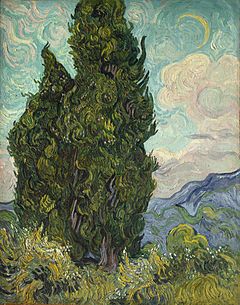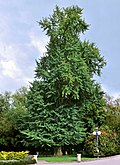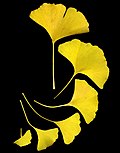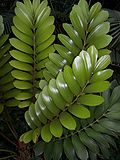
The gymnosperms consist of five orders of seed plants: Cupressales, Cycadales, Ginkgoales, Gnetales and Pinales. They developed more than 350 million years ago, long before flowering plants, according to the fossil record. The name comes from the Greek for "naked seed"; the egg cells are not protected by ovaries, as in flowering plants.
Gymnosperms are divided into 12 families of trees, shrubs and woody vines. Sequoiadendron giganteum, the giant redwood, is the largest tree in the world, and Sequoia sempervirens, the coastal redwood, is the tallest. Ginkgo trees tolerate urban pollutants well, and are often planted in and near cities. The pine family is the main source of softwood timber, paper pulp and turpentine. The flexible wood of the yew family is used in longbows and musical instruments.
Glossary
From the glossary of botanical terms:
- deciduous: falling seasonally, as with bark, leaves, or petals
- unisexual: of one sex; bearing only male or only female reproductive organs
- woody: hard and lignified; not herbaceous
Families
| Family and a common name | Type genus and etymology | Total genera; global distribution | Description and uses | Order | Type genus images |
|---|---|---|---|---|---|
| Araucariaceae (kauri-tree family) | Araucaria, for the Araucanos (Mapuche) | 3 genera, in southern South America, Southeast Asia, and parts of the western Pacific | Evergreens with whorled branches. Many of the larger species are harvested for timber. | Cupressales |   Araucaria araucana Araucaria araucana
|
| Cupressaceae (cypress family) | Cupressus, from Greek and Latin plant names | 30 genera, prevalent in the Northern Hemisphere, and scattered in southern temperate zones | Trees and shrubs with heavily scented resin. Taxodium is an aquatic tree genus with roots that form knees in some species. Many species provide timber that resists fungal and termite damage. | Cupressales |   Cupressus sempervirens Cupressus sempervirens
|
| Cycadaceae (sago family) | Cycas, from a Greek plant name | 1 genus, scattered widely around Southeast Asia, northern Australia, and parts of India and Africa | Unisexual trunked plants with leaf bases that periodically sprout new leaves. The raw plants are toxic for humans, but carefully prepared starches from some species are added to certain Asian dishes. | Cycadales |   Cycas revoluta Cycas revoluta
|
| Ephedraceae (jointfir family) | Ephedra, from Greek and Latin plant names | 1 genus, in northern temperate regions, arid zones, and the Andes and other parts of South America | Mostly unisexual shrubs and vines. Generally, photosynthesis occurs in the branches rather than the leaves. Many plants contain the medicinal compound ephedrine. | Gnetales |   Ephedra distachya Ephedra distachya
|
| Ginkgoaceae (maidenhair-tree family) | Ginkgo, from Chinese and Japanese plant names | 1 genus, in eastern China | Deciduous unisexual trees with fan-like leaves. Trees nearly identical to the modern Ginkgo are frequently found in the fossil record from the Mesozoic Era. | Ginkgoales |   Ginkgo biloba Ginkgo biloba
|
| Gnetaceae (emping family) | Gnetum, from a Maluku or Malay plant name | 1 genus, scattered in the tropics | Unisexual woody vines, and occasionally trees. At least two species are cultivated or gathered for food in Africa and Indonesia. Some plants provide fibre and wood. | Gnetales |   Gnetum edule Gnetum edule
|
| Pinaceae (pine family) | Pinus, from a Latin plant name | 11 genera, scattered widely in the Northern Hemisphere | Evergreen and deciduous conifers, mostly trees and some shrubs, with heavily scented resin. Leaves are needle-shaped or linear. Pinus pinea is grown commercially for pine nuts. Many species are grown as ornamentals, especially for winter holidays. | Pinales |   Pinus palustris Pinus palustris
|
| Podocarpaceae (yewpine family) | Podocarpus, from Greek for "stalked fruit" | 20 genera, scattered in the Southern Hemisphere, in East and Southeast Asia, and in and near Central America and the Caribbean | Evergreen trees and shrubs, with a few species that grow in water or on other plants. Timber production has decreased due to overharvesting. | Cupressales |   Podocarpus macrophyllus Podocarpus macrophyllus
|
| Sciadopityaceae (umbrella-pine family) | Sciadopitys, from Greek for "umbel" or "parasol" (the leaves) + "fir" | 1 genus, in Japan | Evergreen trees with unisexual cones and photosynthetic branchlets | Cupressales |   Sciadopitys verticillata Sciadopitys verticillata
|
| Taxaceae (yew family) | Taxus, from a Latin plant name | 5 genera, scattered mainly in the Northern Hemisphere | Evergreen shrubs and trees with poisonous berry-like cones | Cupressales |   Taxus baccata Taxus baccata
|
| Welwitschiaceae (tumbo family) | Welwitschia, for Friedrich Welwitsch (1806–1872) | 1 genus, in desert regions of southwestern Africa near the coast | Unisexual plants with short, concave stems and two (occasionally three) large torn leaves. Some of them live for more than a thousand years. | Gnetales |   Welwitschia mirabilis Welwitschia mirabilis
|
| Zamiaceae (coontie family) | Zamia, from a Latin plant name | 9 genera, scattered widely in the tropics and subtropics | Unisexual trunked plants with leaf bases that periodically sprout new leaves. Seeds of Dioon edule are prepared and used in some tortillas. | Cycadales |   Zamia pumila Zamia pumila
|
See also
Notes
- The taxonomy (classification) in this list follows the Gymnosperm section of the Angiosperm Phylogeny Website, and largely follows Plants of the World (2017). Total counts of genera for each family come from Plants of the World Online (POWO). (See the POWO license.) Extinct taxa are not included.
- Each family's formal name ends in the Latin suffix -aceae and is derived from the name of a genus that is or once was part of the family.
- Some plants were named for naturalists (unless otherwise noted).
Citations
Some of POWO's data originally appeared in different databases. On the page for each family, these databases (if any) will appear under the "General information" tab.
- ^ Stevens 2023, Gymnosperms.
- Christenhusz, Fay & Chase 2017.
- POWO.
- Christenhusz, Fay & Chase 2017, pp. 71, 652.
- ^ Christenhusz, Fay & Chase 2017, pp. 73–86.
- ^ Christenhusz, Fay & Chase 2017, p. 84.
- ^ Christenhusz, Fay & Chase 2017, p. 75.
- ^ Christenhusz, Fay & Chase 2017, pp. 79–80.
- ^ Christenhusz, Fay & Chase 2017, p. 86.
- Christenhusz, Fay & Chase 2017, pp. 638–670.
- ICN, art. 18.
- Stearn 2002, p. 49.
- Coombes 2012, p. 48.
- IPNI, Araucariaceae, Type.
- POWO, Araucariaceae.
- ^ Stevens 2023, Cupressales.
- ^ POWO, Trees of New Guinea.
- Christenhusz, Fay & Chase 2017, p. 81.
- Stearn 2002, p. 109.
- Coombes 2012, p. 113.
- IPNI, Cupressaceae, Type.
- POWO, Cupressaceae.
- Stearn 2002, p. 110.
- Coombes 2012, p. 114.
- POWO, Cycadaceae.
- ^ Stevens 2023, Cycadales.
- Christenhusz, Fay & Chase 2017, pp. 73–74.
- Stearn 2002, p. 131.
- POWO, Ephedraceae.
- ^ Stevens 2023, Gnetales.
- POWO, Flora of Somalia.
- Christenhusz, Fay & Chase 2017, p. 78.
- Stearn 2002, p. 151.
- Coombes 2012, p. 155.
- POWO, Ginkgoaceae.
- Stevens 2023, Ginkgoales.
- ^ Christenhusz, Fay & Chase 2017, p. 77.
- POWO, Gnetaceae.
- Stearn 2002, p. 241.
- Coombes 2012, p. 234.
- IPNI, Pinaceae, Type.
- POWO, Pinaceae.
- Stevens 2023, Pinales.
- Stearn 2002, p. 244.
- Coombes 2012, p. 239.
- IPNI, Podocarpaceae, Type.
- POWO, Podocarpaceae.
- Christenhusz, Fay & Chase 2017, p. 82.
- Stearn 2002, p. 270.
- Coombes 2012, p. 269.
- POWO, Sciadopityaceae.
- Christenhusz, Fay & Chase 2017, p. 83.
- Stearn 2002, p. 291.
- Coombes 2012, p. 287.
- IPNI, Taxaceae, Type.
- POWO, Taxaceae.
- Burkhardt 2018, p. W-14.
- POWO, Welwitschiaceae.
- Christenhusz, Fay & Chase 2017, p. 76.
- Stearn 2002, p. 313.
- Coombes 2012, p. 309.
- IPNI, Zamiaceae, Type.
- POWO, Zamiaceae.
- Christenhusz, Fay & Chase 2017, pp. 74–75.
References
- Burkhardt, Lotte (2018). Verzeichnis eponymischer Pflanzennamen – Erweiterte Edition [Index of Eponymic Plant Names – Extended Edition] (pdf) (in German). Berlin: Botanic Garden and Botanical Museum, Freie Universität Berlin. doi:10.3372/epolist2018. ISBN 978-3-946292-26-5. S2CID 187926901. Retrieved January 1, 2021. See the Creative Commons license.
- Christenhusz, Maarten; Fay, Michael Francis; Chase, Mark Wayne (2017). Plants of the World: An Illustrated Encyclopedia of Vascular Plants. Chicago, Illinois: Kew Publishing and The University of Chicago Press. ISBN 978-0-226-52292-0.
- Coombes, Allen J. (2012). The A to Z of Plant Names: A Quick Reference Guide to 4000 Garden Plants. Portland, Oregon: Timber Press. ISBN 978-1-60469-196-2.
- IPNI (2022). "International Plant Names Index". London, Boston and Canberra: Royal Botanic Gardens, Kew; Harvard University Herbaria & Libraries; and the Australian National Botanic Gardens. Retrieved December 20, 2022.
- POWO (2019). "Plants of the World Online". London: Royal Botanic Gardens, Kew. Retrieved September 27, 2023. See their terms-of-use license.
- Stearn, William (2002). Stearn's Dictionary of Plant Names for Gardeners. London: Cassell. ISBN 978-0-304-36469-5.
- Stevens, P.F. (2023) . "Angiosperm Phylogeny Website: Gymnosperms". Missouri Botanical Garden. Retrieved September 27, 2023.
- Turland, N. J.; et al. (eds.). International Code of Nomenclature for algae, fungi, and plants (Shenzhen Code) adopted by the Nineteenth International Botanical Congress Shenzhen, China, July 2017 (electronic ed.). Glashütten: International Association for Plant Taxonomy. Retrieved February 25, 2022.